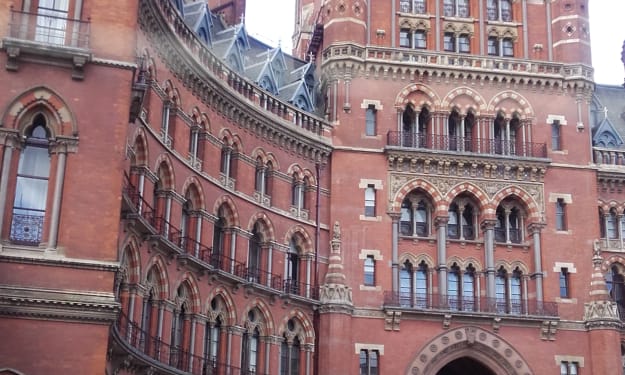The Ever-Natural Ajanta Temple Caves of India
Natural Caves

I nearly got lost until the guide said—'Please, this is the route to the place'. These were his words. The caves are very widespread with about 105 kilometers facing northeast toward a large city and district headquarters in India, in the state of Maharashtra. I stood for some few minutes, and looked at the caves from afar, and all I could say was—' This is the beauty of nature'. The cave of Ajanta was built when Buddhist and Hindu gods were worshiped in Indian culture. They are uniquely designed from steep cliffs that look U-shaped, like square canyons, through a canyon around the Indian Waghur River.
Ajanta was named after the next village. It is interesting to note that the Buddhist caves, with 30 chains of stone monuments which form the link between the caves of Ajanta, were uncovered, and existed between the second century BC, and the sixth century AD. The cave is located outside the village of Ajinṭhā. I am totally convinced that the brilliant caves deserve to be on the UN World Heritage List as they have been since 1983.
Ajanta Caves are some of the largest surviving Indian caves. Visitors periodically come here to experience the site. Suddenly, another cave of 103 km, called Ellora, which is also located in Ajanta, emerged. It took all the 'shine' and pleasure from the Maharashtra based cave. A British Hindu Army officer who served as captain, John Smith, was the discoverer of this cave when he went animal hunting in 1819. The interesting part of this story is that he only went tiger hunting, to be specific, and by accident the caves were discovered.
Ellora is a complete description of the Indian expression of Buddhist religious art, and its achievements, values, and cultural perspectives. The caves are the earliest monastery in India. As already mentioned, the first cave was built around the second century BC. And the second cave was between 400 and 650 CE. These cave explorations are beyond imagination. The first U-shaped cave is located in the northeast of Maharashtra. You cannot stop praising this cave. It is steeper, more open, and more inclined than the other caves. Works of art showing the beauty of painting in the caves, flashy statues, and sculptures bring out the beauty of the cave.
Features of Cave One
Visitors can not control their joy when they come here. This cave is decorated with beautiful stone statues, a terrace, a backyard, and a powerful colonial reception. Each wall in the corridor has a length of about 40 meters, and a height of 20 meters. You may have to prepare for a great trip, because there is enough space for roaming to see beautiful pictures of a horse, bull, elephant, lion, meditating monk, Buddha image with prayer vessel, and wife, angels, and an artwork called "Temptations by Mara." It includes the seduction by Mara's daughters who are depicted below the meditating Buddha.
In addition to the above details, there are also two or more prominent figures of two great people who preceded personal Nirvana to help others attain enlightenment, as well as the above details. Both Vajrapani and Padmapani are located on either side of the entrance to a Buddhist temple.
Features of Cave Two
I call it the "Royal Cave." This is because of the makeup. It is very close to the U-shaped cave, and was built from 475 to 477 CE. Pictures and petroglyphs show how strong women are, and play an important role in society. Most of the images were confirmed by Dieter Schlingloff, a German environmentalist. As our global society grows in fits and starts, women are the forces that need to be considered in the development process.
The first thing you see when you enter the king’s cave are beautiful artifacts, sturdy columns, and stylish ceilings in this reserve. The main hall of the building is a narrow rectangular shape with an arched ceiling, literally “Stupa House.” These chaitya-griha are called the prayer rooms. Visiting children will be very enthusiastic about the great works of art that shows children learning in school, some listening to their teachers with rapt attention, while others display other things on the wall. All these happened in the fifth century, and were dedicated to the Buddhist goddess of fertility, Hariti.
Another cave in the middle of the two is a cave with two large images resembling elephants. As soon as you enter, it just hits your face. An elephant is said to have sacrificed itself to those who were starving. The old staircase is a small multi-story building, officially dedicated to the monks of the community. In this very important cave is a belief system that understands the sequence of events in the second and last stages of the construction of the cave complex. The monastery has a main gate, two entrances, and two illuminated windows. Outside it is a rectangular road on each side that forms a monastery.
One of the 29 caves in the monastic complex of Ajanta, which captures everything, is the most exquisite cave, which has the same characteristics as any other cave, but has a ubiquitous drawing of gods and goddesses from Indian history and origin. All caves are given as identifiers. From 1 to 29 were the names of caves. Ajanta Caves and Ellora Caves became the most popular tourist destinations in Maharashtra, and are often crowded during the holidays, increasing the threat to caves, especially the images.
Into The Paintings
The Ajanta Cave Painting seems to be the first, and most important, fresco in India. This story can not be contested. All other types of painting, such as palace images, wood arts, fabrics, or palm leaf paintings, have not been stored for 1000 years. The quality of the painting clearly shows that artists know what they are doing, especially in religious matters. Different types of stones, minerals, and plants were used in combination to create a wonderful art piece. Quality sculptures are usually covered with cement screeds for a soft finish, and gloss paint. And you can find it here. Pictures in Ajanta caves basically tell the story of Jataka. These are Buddhist legends describing the previous births of Buddha.
Brief Outlook Before Travelling
The Ajanta Caves visiting hours are between 09:00 AM and 05:00 PM.
Address: Ajanta Caves Road, Aurangabad, Maharashtra 431001
Opening Days: All days apart from Mondays
How Do You Get to the Ajanta Caves?
After arriving at the Indian city of Mumbai, follow up to Aurangabad, which is almost 333 kilometres from Mumbai. From Aurangabad city centre, the Ajanta Caves are about 102 kilometres away from the Aurangabad—Ajanta—Jalgaon road. You only need a local taxi as the preferred way of making the trip to Ajanta. If you are driving, you should ply the highway, which links from Aurangabad to Mumbai. This stretch joins other major cities in the country such as Delhi, Jaipur, Udaipur, Bijapur, and Indore. So get to the nearest Metro Station to Ajanta Caves. Unfortunately, there isn't a metro rail service available in this area. Just join the Maharashtra State Road Transport Corporation (MSRTC) bus to the north of Siddharth Garden and the Zoo. Alight or drop off at the Ajanta Caves entrance road. You are then safe on arrival to the Ajanta Caves. Your fare is only 120 rupees. Another option is to get to the nearest airport to Ajanta Cave. Aurangabad Airport is about five miles from the city center, and is the closest airport to the Ajanta Caves.
The Entrance Fee
Due to the numbers that troop here every now and then, the cave entrance is lined up with cafes, restaurants, souvenir shops, and lots more. The crowds visiting the cave were a bit higher than expected, so in 2012, the Maharashtra Tourism Development Corporation (MTDC) announced plans to include replicas of caves 1, 2, 16, and 17 to reduce crowding in the originals, and enable visitors to receive a better visual idea of the paintings, which are dimly-lit, and hard to read in the caves. Entrance ticket for Indian tourists is INR 40. However, a foreigner pays INR 600. The entry is free for kids under the age of 15. You can equally book your ticket online in order to avoid waiting in long queues at the site.
About the Author
Osei Agyemang is a passionate and creative content writer / editor who is an expert in writing interesting, and innovative contents. Osei is also an addicted travel enthusiast who likes to visit, and tell the stories of interesting places around the world. He is an award winning National Artist who studied Psychology, Journalism, and Global English Language at University of Strathclyde, and the University of Glasgow respectively.
Email: [email protected]
About the Creator
Osei Agyemang
https://www.oseiagyemang.com:
A passionate writer who creates exciting and innovative contents. Osei Agyemang is also a tourism fan who loves to travel around the world. He has studied Psychology and Journalism.






Comments (1)
nice information